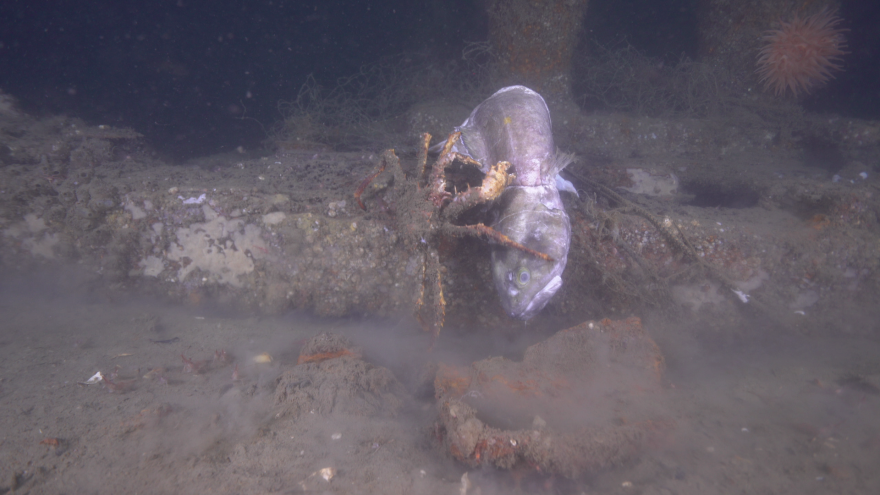Stellwagen Bank is a federally protected marine sanctuary located north of Cape Cod at the mouth of Massachusetts Bay. The marine sanctuary is home to more than 200 sunken shipwrecks, many of which are hotspots for marine debris.
This summer, a team of Woods Hole scientists received a grant from the federal government to figure out how to deal with all this marine debris.
Woods Hole Oceanographic Institution biologist Kirstin Meyer-Kaiser is one of the scientists leading the project. As a diver as well as a biologist, Meyer Kaiser has seen some of these debris-riddled wrecks first-hand.
Gilda Geist What is an underwater cultural heritage location?
Kirstin Meyer-Kaiser Underwater cultural heritage refers to shipwrecks, but also sunken airplanes, Paleolithic middens, break walls, lighthouses. It is the remains of human activity in the ocean that has accumulated over history.
GG Are there any examples around here you can point to?
KM The steamship Portland sank in 1898, and it had approximately 200 people on board at the time. Unfortunately, there were no survivors.
When I was doing a previous project looking at the animals that live on the Portland in 2019 and 2020, I became very deeply aware of the problem of marine debris getting entangled on our underwater cultural heritage.
GG Can you tell me a little bit more about why that’s a problem?
KM It's actually this really kind of complex, multilayered system, because in most cases a fisherman doesn't know that there is a shipwreck on the seafloor.
A lot of fish tend to aggregate around shipwrecks, which means that they also tend to be targeted by fishermen. And so they would go to trawl over a shipwreck area to try to collect those fish, and unfortunately, the net gets tangled. And when a net gets tangled, the fisherman is forced to cut that away, which is the only way to save the boat.
It's also a tragedy for the fishermen that just lost the expensive nets that they've invested in and rely on for their livelihood, and it's a tragedy for our collective maritime heritage.
GG Is there any concern about those nets getting other creatures down there tangled as well?
KM Oh yes. When we were researching the Portland in 2019, we were finding fish actually entangled in the net as it was itself entangled on the Portland. There was this one cusk, which was caught in the net, and there was a spider crab that was feasting on the dead body of the fish because nets continue to fish after they have been left on the seafloor.

GG So now let's talk about your project, which I see has three parts. We’ve got removal, prevention and education. Can you speak more about that removal aspect?
KM This component is actually led by my colleague, research engineer here at WHOI named Robin Littlefield. The premise is to design and implement an underwater robot that can remove entangled nets from shipwrecks.
The idea is that we'll be able to scope the requirements for that vehicle work to develop it, so that we actually have that net cutting capability, and then use a few shipwrecks in Massachusetts as test cases. It's going to be a tethered vehicle with a person on the boat being able to control that live.
GG We hear so much about how human activity has negative effects on the ocean. But some of these wrecks are, like you said, habitats. So is this one random anthropogenic impact that actually has some good to it?

KM That is a very complicated question. The big answer is we need to do more research on it.
Shipwrecks provide habitat. We know this. We also know that shipwrecks provide novel structures. So something that stands high off the seafloor. The underside of an overhang—that never occurs with just low-lying boulder reefs that naturally occur. But they are hotspots of biodiversity that you find on shipwrecks. There are also some darker sides to it, because shipwrecks tend to be stepping stones for invasive species.
What I find so fascinating is that humans and their environment interact over time. So if you imagine a seascape, obviously the humans are going to spend more time in the productive area. So that's where the fisheries are going to be concentrated. But then where the fisheries are, that's also going to be where the shipwrecks are, because where the ships are, ships will sink. So then you have an uneven distribution of shipwrecks across that seascape. Okay, but now the shipwrecks become hotspots of biodiversity themselves. And so over time, this feedback of human and natural systems leads to the world that we see.








